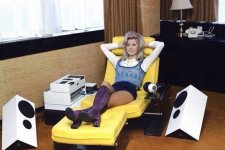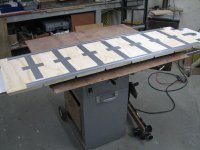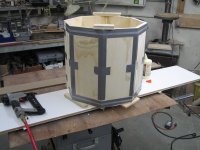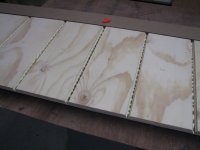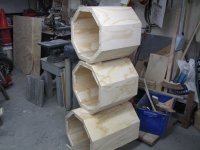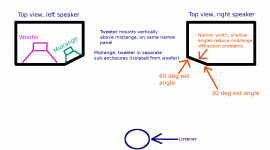It is not a cure-all. One of the boxiest sounding speakers i have heard were OBs.
dave
Almost an oxymoron! I suspect the designer didn't know what he was doing.
I used to have a pair of Wharfedale 220s, chosen because they had a sweet midrange, with a lot less boxiness than many of its rivals. (No doubt thanks to use of fairly extensive internal sound absorption - something which Wharfedale seems to be taking very seriously these days.)
They've been replaced by a baffle-less system. Midrange is now far more open - and free from boxiness (which I detest).
Of course. That would be very easy to do with a crap baffle.It is not a cure-all. One of the boxiest sounding speakers i have heard were OBs.
dave
Sure, but with reports of good and bad monopoles and open baffles, it might be possible to stop assuming an actual box issue, and attribute it to something else (eg resonances?)
As for baffle-less, I've seen measurements, there could be potential here. However I don't yet see a reason to connect this with baffles or boxes, or lack thereof.
As for baffle-less, I've seen measurements, there could be potential here. However I don't yet see a reason to connect this with baffles or boxes, or lack thereof.
That would be very easy to do with a crap baffle.
Inch & a quarter good plywood built to Silver Iris specs.
dave
Perhaps because we're unaware of their full possibilities! 😉"Why are triangular enclosures not more common here?"
Attachments
I tape and fold.
Yup.
Attachments
Perhaps because we're unaware of their full possibilities! 😉
Early 70's?
Thanks for the pics of what you meant by 'tape and fold'. (post #70)
I was completely stumped.😱
Cheers
I was completely stumped.😱
Cheers
Add an excess of yellow glue and tack in place once folded. Add reinforcements as needed after that. Depending on the size reinforcements may not be needed. Yes I know these aren't triangle but the theory from Cowan still make sense.
Attachments
It is important to use something semi strong like duct tape for the 'hinges' and fibreglass tape with its incredible strength for the 'strapping'. If you don't, you will learn lessons I can save you from. When you look at the pics in post 70, you can see how to be a pro the first time.
Time to give away a speaker enclosure idea I experimented with a long time ago, working on it with some clever colleagues at a long-gone job.
I must apologize for the crudeness of the attached image - I'm no graphics professional.
The black outline shows the walls of the speaker enclosure, seen from vertically above. The cross-section is pentagonal. The angled panel is just wide enough for the midrange (plus thickness of wood, a wee margin, etc).
The narrow midrange panel, combined with radiused edges, combined with the relatively shallow angles at which that panel met its neighbouring panels (30 degrees and 60 degrees) did a pretty good job of minimising diffraction problems from the midrange and tweeter.
The tweeter was mounted vertically above the midrange, on the same narrow angled panel (remember, the image is a top view). All drivers were flush-mounted to the front panel, of course; and rear edges of all speaker cutouts were chamfered. The tweeter used a faceplate with a shallow horn to control directivity, and that helped improve the imaging even more (probably because there was less sound traveling along the front panel and "lighting up" the edges to cause diffraction problems).
The woodworking is obviously more complex than a "right rectangular prism" enclosure, but 30 degree and 60 degree cuts are relatively easy to do - many table saws and so on will have those angles marked with detents.
My memory of this speaker (pair) is that it had really excellent stereo imaging. The oddball enclosure shapes did what we were hoping they would do, providing many of the diffraction benefits of a curved (cylindrical) front baffle, without most of the complexity.
Because of the angled midrange/tweeter panel, the recommended listening location pointed the midrange and tweeter straight at your head, without having to toe-in the boxes as we do with our usual "right rectangular prism" enclosures.
Even our simplified shape still needed different left-right mirror image enclosures, along with those oddball 30 and 60 degree angles, so it would have cost more to produce than the usual right rectangular prism box.
The woofer could probably have faced in pretty much any direction (the crossover frequency was low enough so it wouldn't have mattered), but customers like to see their woofers, so we put it on the front panel, which was just about wide enough to accommodate it.
The other reason for putting the woofer on the front panel is that we found most prospective customers thought their stereo imaging was coming from the woofer. It's actually the midrange that matters most for imaging, but there was no harm in putting the woofer on the front panel, so we did.
If anyone feels like experimenting with a non-rectangular enclosure that's not incredibly difficult to make, you might give this one a try and see if you like the results. I think it has a lot of nice subtle improvements over the usual box shape.
-Gnobuddy
I must apologize for the crudeness of the attached image - I'm no graphics professional.
The black outline shows the walls of the speaker enclosure, seen from vertically above. The cross-section is pentagonal. The angled panel is just wide enough for the midrange (plus thickness of wood, a wee margin, etc).
The narrow midrange panel, combined with radiused edges, combined with the relatively shallow angles at which that panel met its neighbouring panels (30 degrees and 60 degrees) did a pretty good job of minimising diffraction problems from the midrange and tweeter.
The tweeter was mounted vertically above the midrange, on the same narrow angled panel (remember, the image is a top view). All drivers were flush-mounted to the front panel, of course; and rear edges of all speaker cutouts were chamfered. The tweeter used a faceplate with a shallow horn to control directivity, and that helped improve the imaging even more (probably because there was less sound traveling along the front panel and "lighting up" the edges to cause diffraction problems).
The woodworking is obviously more complex than a "right rectangular prism" enclosure, but 30 degree and 60 degree cuts are relatively easy to do - many table saws and so on will have those angles marked with detents.
My memory of this speaker (pair) is that it had really excellent stereo imaging. The oddball enclosure shapes did what we were hoping they would do, providing many of the diffraction benefits of a curved (cylindrical) front baffle, without most of the complexity.
Because of the angled midrange/tweeter panel, the recommended listening location pointed the midrange and tweeter straight at your head, without having to toe-in the boxes as we do with our usual "right rectangular prism" enclosures.
Even our simplified shape still needed different left-right mirror image enclosures, along with those oddball 30 and 60 degree angles, so it would have cost more to produce than the usual right rectangular prism box.
The woofer could probably have faced in pretty much any direction (the crossover frequency was low enough so it wouldn't have mattered), but customers like to see their woofers, so we put it on the front panel, which was just about wide enough to accommodate it.
The other reason for putting the woofer on the front panel is that we found most prospective customers thought their stereo imaging was coming from the woofer. It's actually the midrange that matters most for imaging, but there was no harm in putting the woofer on the front panel, so we did.
If anyone feels like experimenting with a non-rectangular enclosure that's not incredibly difficult to make, you might give this one a try and see if you like the results. I think it has a lot of nice subtle improvements over the usual box shape.
-Gnobuddy
Attachments
Because of the angled midrange/tweeter panel, the recommended listening location pointed the midrange and tweeter straight at your head, without having to toe-in the boxes as we do with our usual "right rectangular prism" enclosures.
-Gnobuddy
But if the operative trick here is the 30 and 60 deg. angles, why would placement be limited to a particular orientation? This would limit the listener to a specific distance from the enclosures placed a specific distance apart with no other option, no? Looks like a great design and I don't see any limitations on placement at all for optimum performance other than correct symmetry as would be required with any other design. OTOH, I could be wrong, it has happened in the past.🙂
It's been twenty-odd years, and I don't remember all the details. I remember that we were using an 8" woofer that had been designed more like a typical subwoofer, and with a little bottom-end EQ, was able to get down to some 30-40 Hz or so (though one could certainly argue if there was usable SPL down there. Good for ad copy, though.)Interesting design. How low was the crossover point?
As best I remember, the midrange was a 4", and the panel on which it was mounted was barely wider than that (allowing for the radius on the two long edges). I don't remember the exact crossover frequency, but it might have been around 200 Hz or so - it was chosen based on power handling ability, mostly, as the woofer was reasonably good up to 1 kHz or so.
Edit: thinking about it now, one could use an MTM layout with two midranges on the angled panel, which would allow the woofer-midrange crossover frequency to be moved lower and/or allow increased SPL near the lowest frequencies in the midrange's band.
This design was intended to be a near-field speaker, so it didn't need to be able to generate enormous SPL at a large distance, which allowed the use of a relatively low crossover frequency to the midrange.
The prototype was tri-amped, with active crossover networks implemented in DSP, so we could tweak and fiddle things easily. Standard stuff today, but fairly forward-thinking twenty years ago.
-Gnobuddy
Last edited:
Call it a suggested starting point. 🙂 Certainly the speaker positions and orientations are not cast in stone.But if the operative trick here is the 30 and 60 deg. angles, why would placement be limited to a particular orientation?
Starting out with the listener's head and the two speakers at roughly the corners of an equilateral triangle are not a bad idea for near-field listening, which is what this design was originally created for. The target market was near-field monitoring in semi-pro audio / home studios. The product never made it to market (for reasons unrelated to its performance, which was very good).
The 30 and 60 degree angles just made a lot of practical sense. Relatively easy to manufacture, points the midrange and tweeter more or less in the right direction, solves some of the diffraction problems that come with a wide flat front baffle, etc.
-Gnobuddy
- Home
- Loudspeakers
- Multi-Way
- Why are triangular enclosures not more common here?
